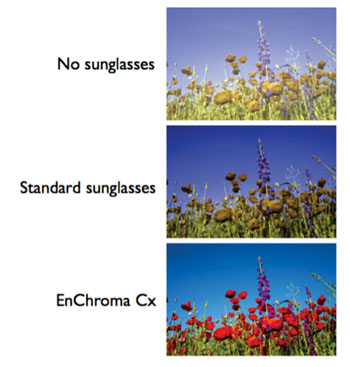Correcting Glasses Reestablish Indoor Color Vision
By HospiMedica International staff writers
Posted on 01 Apr 2015
Innovative glasses enable red-green color vision deficiency (CVD) sufferers see digital display screens and status indicator lights when performing color-based activities.Posted on 01 Apr 2015
The EnChroma Cx-65 eyewear for indoor use are based on Digital Color Boost (DCB), an optical coating technology for lenses that defines a series of precise “cutouts” along the spectrum of light, removing the wavelengths that sit between the primary colors and amplifying the color signal sent to the brain. DCB coatings are made from up to 100 layers of dielectric material, with each individual layer only a few nanometers thick. Due to quantum interactions at the boundaries between layers, photons passing through the coating are selectively blocked, depending on their wavelength.

Image: Simulation of color correction using EnChroma Cx (Photo courtesy of EnChroma).
The EnChroma Cx line uses a special extra-strength version of the DCB coating that removes wavelengths of light where the overlap is occurring between the red and green cone cells. By doing so, the spectral shift can be reversed, amplifying the color signal sent to the brain. The result is that colors appear to be brighter and more pure, thousands of more shades can be seen, and they can be recognized more quickly and with less confusion. EnChroma Cx eyewear are products of EnChroma (Berkley, CA, USA), and are available as sunglasses as well.
“A lot of EnChroma sunglass wearers wanted an indoor version so they could bring the experience of seeing certain colors for the first time to their lives at work and at home,” said Tony Dykes, CEO of EnChroma. “Everything from learning at school or presenting a colorful slide show at work, to debating friends about the infamous 'gold-and-white or black-and-blue dress,' is much easier with EnChroma Cx indoor glasses.”
Red-green color blindness is caused by a genetic defect carried on the X-chromosome; the condition affects 8% of males and 0.4% of females. There are two types of red-green color blindness; deutans, which are 75% of cases, have a defect in the green cone cells; the defect causes the green cone cell to be spectrally shifted towards red (green becomes more like yellow). Protans, which are 25% of cases, have a defect in the red cone cells which causes the red cone cell to be spectrally shifted towards green (red becomes darker and more like orange).
Related Links:
EnChroma














